भारत में सूरजमुखी का एक सिंहावलोकन
Sunflower (Helianthus annuus L.) is one of the few crop species that originated in North America. It was probably first introduced to Europe through Spain, and spread through Europe as a curiosity until it reached Russia where it was readily adapted. The high-oil lines from Russia were reintroduced into the U.S. after World War II, which rekindled interest in the crop. Production of sunflower subsequently increased in the Great Plains of United States as marketers found new uses for the seeds as an oil crop, a birdseed crop, and as a human snack food. In India, sunflower as an oilseed crop introduced in 1969, prior to which it was used as an ornamental plant (Wikipedia).
Six states with Karnataka in the lead are the major producers of sunflower in the country. Karnataka with a production of 3.04 lakh tonnes from an area of 7.94 lakh hectares followed by Andhra Pradesh, Maharashtra, Bihar, Orissa and Tamil Nadu are major sunflower producing states of India (Fig 1). Sunflower production follows a systemic weather risk as about 80 per cent of the area is under rain-fed production. In terms of productivity, Bihar leads with 1402 kg/ha followed by Tamil Nadu with 1328.7 kg, although both the states have less than 25000 hectares under the crop which is mostly irrigated. The average productivity at all India level was 900 kg/ha depending on the climatic conditions and irrigation, which are critical factors for high yields.
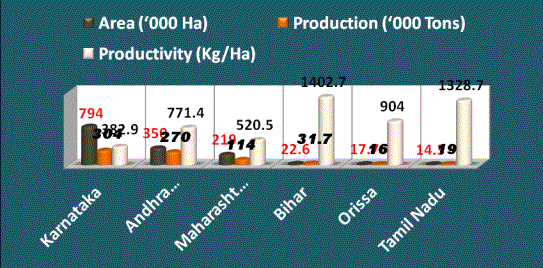

Fig 1: Area, Production & Productivity of Sunflower in Major Producing States
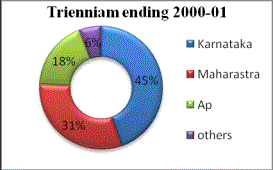
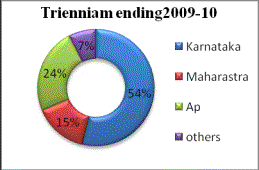
Area
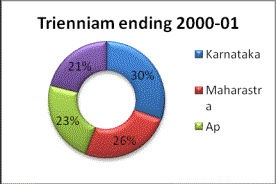
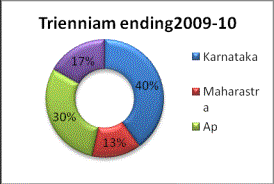
Source: FAO stat
Production
Fig 2: Shifts in Relative Share of Sunflower Area and Production in India.
There is a considerable shift in acreage and production of sunflower which is shown in figure 6. In 2000-01, Karnataka, Maharashtra and Andhra Pradesh were leading with 45 per cent, 31 per cent and 18 per cent, respectively covering almost 94 per cent of total acreage of sunflower in India which then found shifted to Karnataka accounting for 54 per cent in 2009-10 from the previous level of 45 per cent share (2000-01) followed by Andhra Pradesh with 24 per cent. Maharashtra reported substantial reduction in sunflower area between 2001 and 2009 registering 31 per cent & 15 per cent of sunflower area respectively. Country as whole has registered negative growth in sunflower area (Fig 2).
Agronomy
Sunflower is sown by Dibbling method which requires 5-6 kg seed per hectare, while furrow sowing needs 8-10 kg per hectare. The excess seedlings are thinned 10-15 days after seedling emergence. Seeds should be treated with captan or ceresan @ 3 g/kg seed under dry land conditions. In downy mildew prone areas, seed treatment with apron 35 SD @ 6 g/kg seed is necessary. Climatic conditions with relative humidity of 50 to 85 percent, could render seeds to lose viability within 40-60 days. The optimum population varies from 40-74,000 plants/ha depending on variety and availability of moisture. Under dry land conditions, 40-50,000 plants/ha, while under irrigated conditions, 50-60,000 plants/ha is the optimum plant density. A plant density of 55,556 plants/ha (60 cm x 30 cm) in tall cultivars and 74,000 plants/ha (45 cm x 30 cm) in dwarf cultivars/hybrids has been found to be optimum.
Manures and Fertilizers
Sunflower is an exhaustive crop and responds well to application of manures and fertilizers. Application of 10-12 tonnes of FYM or compost/ha is necessary especially in dry lands and poorly fertile soils.
Water management
Usually no irrigation is needed for kharif crop. However, one irrigation may be given in case of uneven distribution of rainfall. Rabi crop may be irrigated thrice after 40, 75 and 110 days of sowing. Sunflower crop is highly sensitive to water stress between flowering and grain filling stages. Therefore, one irrigation may be provided in case of moisture deficiency during this stage. Irrigation requirement of crop during summer is relatively higher. Irrigation at grain-filling stage should be light and given on calm and windless evening to avoid lodging. Among the various stages, bud initiation, flowering period and seed development stages are critical stages in terms of irrigation.
Marketing
Sunflower is a notified commodity in all the APMCs of Chitradurga district. Buyers offer prices upon visual examination of whole lot of the produce considering quality factors like size, colour, moisture content, shelling percentage and ratio of weight to volume. In order to ensure remunerative prices to farmers as well as to gain the confidence of consumers, sunflower should be graded systematically according to the grade specifications defined by Agmark.
Marketing Channel
Chitradurga is one of the leading markets for sunflower in Karnataka. The produce moves through different marketing channels to reach final consumers. Producer farmer sells the produce at farm gate itself or takes to APMC soon after harvest. Traders/Commission agents in the mandis dispatch the produce to buyers within or outside the district. The oil millers distribute oil to wholesale buyers and meal is used in poultry or cattle feed. The oil recovery is about 35 per cent; the rest is cake (63%) and wastage (2%). The cake may also be distributed to solvent extraction unit for further oil extraction where another 12 per cent of oil is extracted and the de-oiled cake is used in poultry feed manufacturing. The extracted oil is distributed to wholesaler and thereafter to retailer and to final consumer (Fig 4).
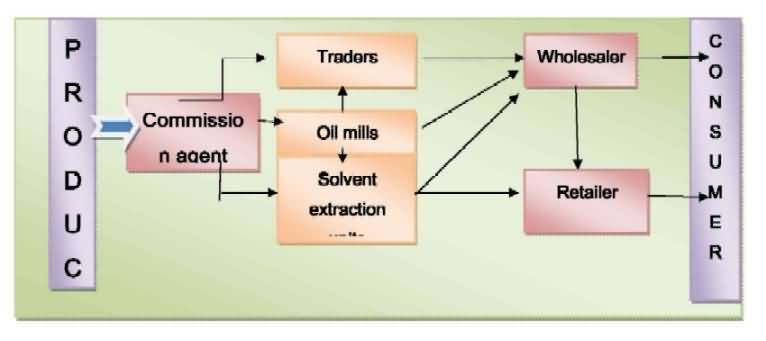
Fig 3: Marketing channels of Sunflower in Karnataka.
Export & Import of Sunflower
European Union, Russia, Ukraine, United States, Argentina, Canada and China are the major exporters of sunflower seed in international market. The major importers include Turkey, European Union, Pakistan, United States and Argentina. The E.U. and U.S. are net exporters of sunflower seeds, while, Argentina is a net importer. European Union, India, Turkey, Egypt, Algeria and Iran are the top importers of sunflower oil. India imports sunflower oil mainly from Ukraine, Russia and Argentina. There is no import duty on crude sunflower oil while for refined oil the duty is 7.5 per cent. Export of sunflower oil with a container weighing more than 5 kg is banned from India.
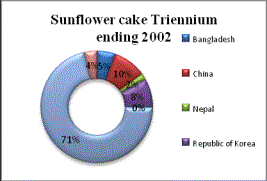
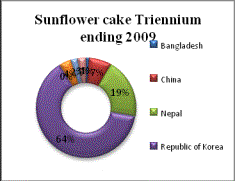
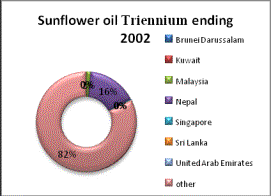

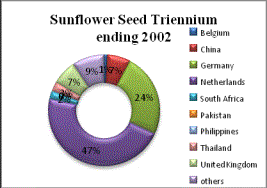
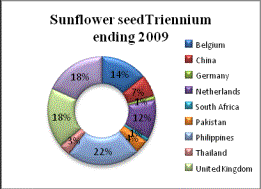
Source: FAO stat
Fig 4: Shifts in Relative Share of Sunflower Export
India majorly exports sunflower cake which increased from 5511.33 tonne (triennium ending 2002) to 18440 tonne during 2009. The direction of sunflower meal trade shows that Nepal and Republic of Korea have improved their share while the United States and Bangladesh have lost their relative shares between 2002 to 2009 period (Fig.5). India exported 912 tonne sunflower oil in 2002 which increased to 3041 tonne for the triennium ending period 2009. The sunflower oil exports to United Arab Emirates and Singapore have increased, while that of Nepal and the other countries share has decreased substantially. Export of sunflower as seed has increased about three times from 1317.33 tonne to 4396 tonne. Among the major buyers of sunflower seed, UK, Philippines, Pakistan and Belgium have improved their relative position, while the Netherlands and Germany have drastically reduced their imports from India between 2005 and 2009 period.
Sunflower import shows that between 2005 and 2009 shows that India depended on Argentina for major part of her imports. The shifts in import pattern show that Russian Federation, Ukraine and the Netherlands meet major portion of import demand of India's demand for sunflower in the form of seed for further value addition. Negligible quantities of oil and meal are imported by India (table 1).
Table 1: Shifts in Relative Share of Sunflower Import
| Sunflower seed (tonne) | ||
| Country Name | Triennium ending 2005 | Triennium ending 2009 |
| Argentina | 70596 | 65879 |
| Germany | 1 | 9 |
| Netherlands | 0 | 3333 |
| Russian Federation | 0 | 24167 |
| Ukraine | 0 | 203255 |
| United Arab Emirates | 830 | 16 |
| United Kingdom | 0 | 1 |
| thers | 1509 | 691 |
| Sunflower oil (tonne) | ||
| Country Name | Triennium ending 2005 | Triennium ending 2009 |
| China | 0 | 0 |
| Germany | 0.3 | 5 |
| Russian Federation | 0 | 937 |
| United States of America | 0 | 1 |
| others | 1.7 | 1479 |
| Sunflower cake (tonne) | ||
| Country Name | Triennium ending 2005 | Triennium ending 2009 |
| Nepal | 259.7 | 62.3 |
| United Republic of Tanzania | 0 | 2065 |
Summary & Conclusions
Sunflower is one of the fastest growing oilseed crops in India popularly known as "Surajmukhi." Majority of the present day varieties grown all over the world is originated from former USSR. In India, sunflower as an oilseed crop was introduced in 1969. Prior to which it was used mainly as an ornamental plant. Sunflower seed is the largest oilseed crop in Russia and Ukraine while in European Union sunflower contributes more than 20 per cent of its oilseeds production and is the biggest oilseed crop after rapeseed. Seeds are used as nutritious snack and also for bird feed. Sunflower oil is popular as healthy cooking oil due to its health benefits while the meal is used in animal feed industry. Among sunflower products, meal is the most traded in world market.
The world sunflower seed production stood at 32.39 million tonnes from an area of 23.71 million hectares, accounting for 8.5 per cent of the total oilseeds production. The major uptrend in acreage and production started during 70s and 80s and the production outbreak started during the period when Russian federation and Ukraine added their acreages, with 14 per cent and 10 per cent along with Argentina adding another 17 per cent during 1992. Russia was the largest producer of sunflower occupying 18.9 percent of area with 13.3 percent of production in the world followed by Ukraine (13.9 per cent), India (8.7 per cent) Argentina (7.6 per cent), China (4.9 per cent), Romania (4.2 per cent), and France (2.6 per cent) during 2009-10.
Reference
- Al-Sharkas, A. (2004), "The Dynamic Relationship Between Macroeconomic Factors and the Jordanian stock market?, International Journal of Applied Econometrics and Quantitative Studies, Vol.1-1, pp. 97-114.
- Engle, R. E. and C. W. J. Granger. 1987. Cointegration and error-correction: representation, estimation, and testing. Econometrica 55: 251-276.
- Giussani, B and Hadjimatheou, G. (1990). House Prices: An Econometrics Model for the UK, The APEX Centre Economics Discussion Paper, 90/1.
- Johansen, S. (1991), "Estimation and Hypothesis Testing of Cointegration Vectors in Gaussian Vector Autoregressive Models", Econometrica 59, 1551-1580.
- www.commoditiescontrol.com
- www.faostat.fao.org
- www.indiatat.com
- www.wikipedia.com
Authors:
Akshata Nayak, Dr C.P. Gracy, Nagashree N. and Girisha K.
Dept. of AGMACO & BM,
GKVK Campus,UAS-B, Bangalore-560065
email:
